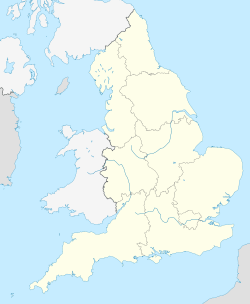Tripontium facts for kids

Remains of the bath houses being excavated in 2005.
|
|
| Location | Warwickshire, England |
|---|---|
| Region | Britannia |
| Coordinates | 52°24′33″N 1°12′46″W / 52.409152°N 1.212683°W |
| Type | Settlement |
| History | |
| Founded | Around AD 50 |
| Abandoned | 4th century |
| Periods | Roman Empire |
| Site notes | |
| Ownership | Commercial company, multiple owners |
| Public access | none |
Tripontium was an important town in Roman Britain. Its name means "Place of three bridges" in Latin. This name likely refers to bridges over the River Avon and two smaller rivers nearby.
Tripontium was located on a major Roman road called Watling Street. Today, this road is known as the A5. The town's remains are mostly in Warwickshire, England, near the modern towns of Rugby and Lutterworth.
Contents
What Was Roman Tripontium Like?
Tripontium started as a military outpost around AD 47. This was soon after the Romans invaded Britain. Its purpose was to help control the new Roman frontier.
Over time, Tripontium grew into a busy civilian town. People lived there for about 400 years. The town was most active in the 2nd century. It was abandoned in the late 4th century when the Romans left Britain.
Historians believe Tripontium was the most important Roman settlement in its area. It was probably a key stopping place for travelers. Both Roman soldiers and ordinary people would have used its facilities. It might also have been a center for local Roman government.
Why Was Tripontium Important?
Tripontium was mentioned in the Antonine Itineraries. This was a Roman document from the 3rd century. It listed places where Roman Emperors and travelers would stop. This shows Tripontium was a recognized and important location on the Roman road network.
The town had large public bath houses and a big inn. An mansio was like a hotel for official travelers. These large buildings suggest many people passed through Tripontium.
Finding and Exploring Tripontium
For many centuries, the exact location of Tripontium was a mystery. Then, in 1836, an expert in old things named Matthew Bloxam found it.
Digging Up the Past
Archaeological digs at Tripontium began in 1961. The Rugby Archaeological Society led these efforts. The excavations continued until 2006.
At first, people thought Tripontium was just a small roadside village. But the excavations showed it was much more important. Archaeologists found evidence of large public bath houses. They also uncovered a big administrative building. A basilica was a large public hall used for business or law.
Many Roman objects have been found at the site. These include pieces of pottery, Roman coins, and other remains. Some parts of the town have been damaged by modern gravel mining. This means not all of the site can be explored. However, archaeologists believe more buildings, like a temple or a forum, are still hidden underground.
The excavation of Tripontium is special. It is one of the largest digs ever done by an amateur archaeological society.
Protecting the Site
Tripontium is a scheduled ancient monument. This means it is a nationally important historical site. It is protected by law.
However, the site is on the Heritage at Risk Register. This is because of risks like illegal metal detecting. Its condition is slowly getting worse.
The Tripontium site is not open to the public. But many of the amazing finds from the excavations are on display. You can see them at the Rugby Art Gallery and Museum.


